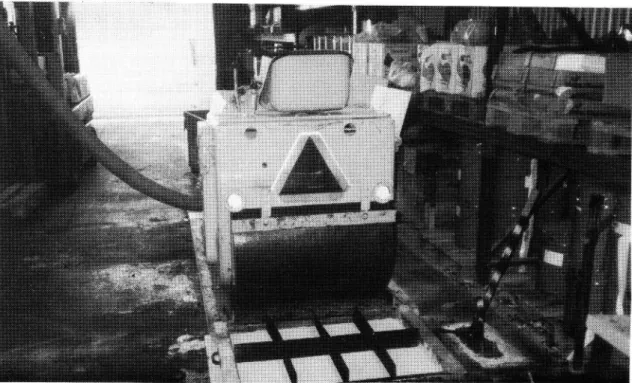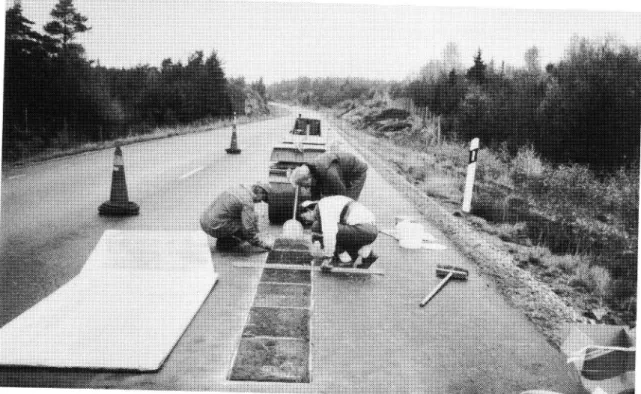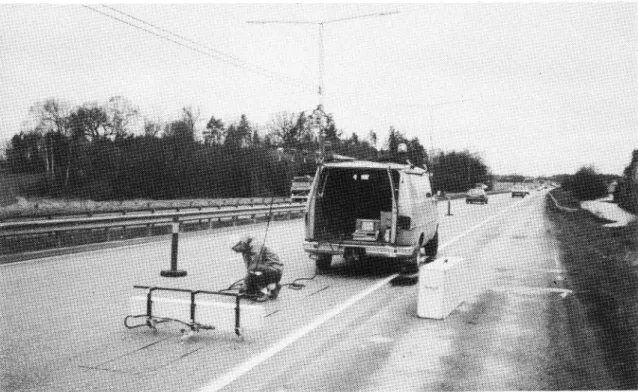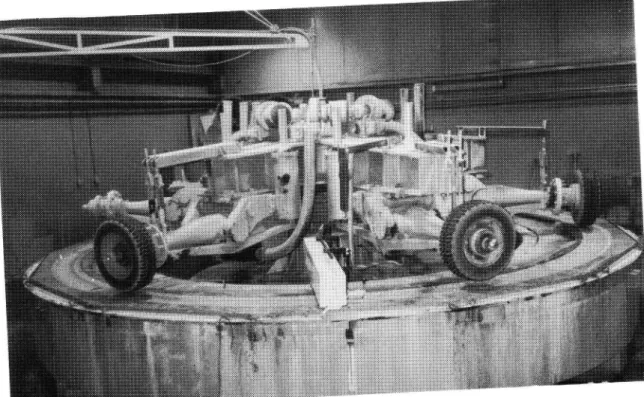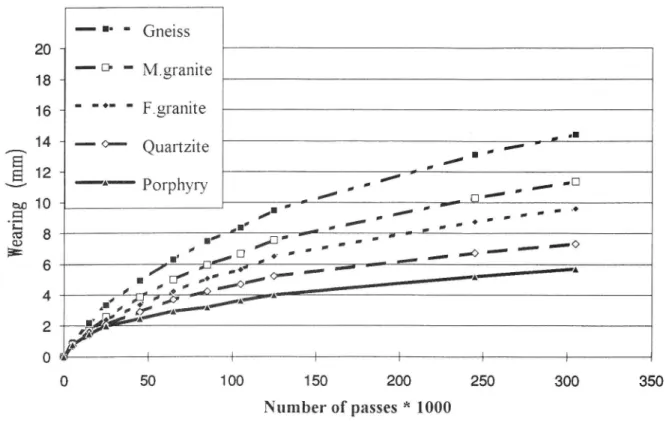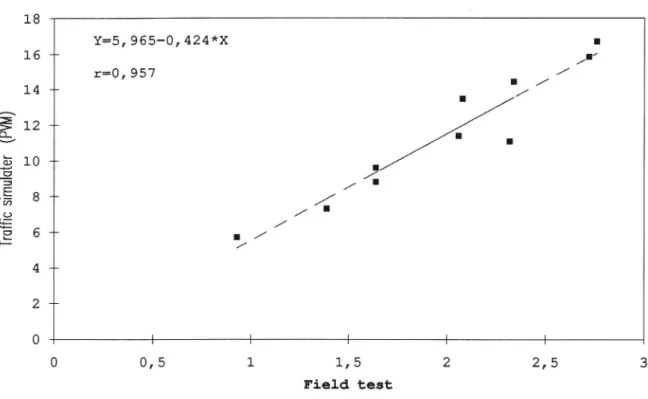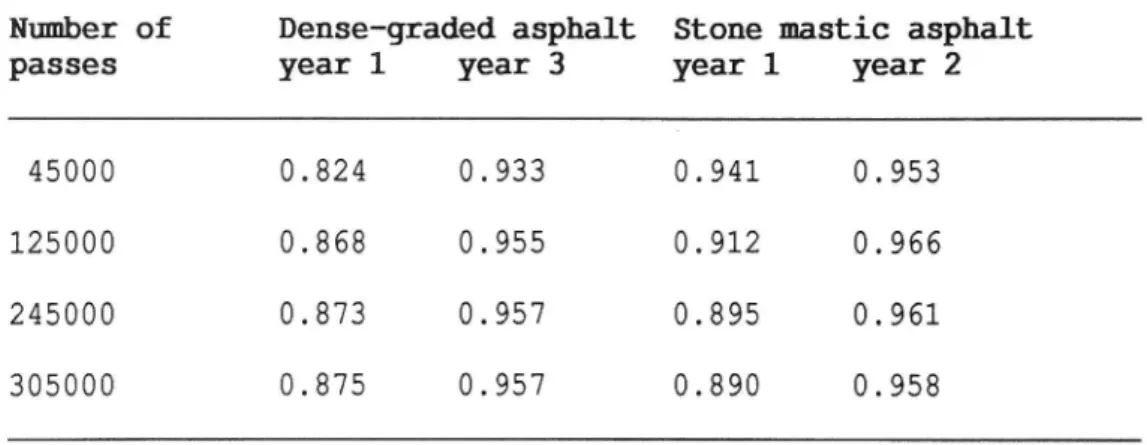& ww .. . .v "ww w./ ..? . .. ./ ,, av: JW ,.
Nr 193
Tb )
tyres
VVearresi
]ö
%.. . ... /© %. é. ./ ..1993
and correlati
stance of bi
on W|th VTI
rnJacobson
Prepared for presenta
Stockholm 7993
A novel approach to fi
tuml
OHS ml
s traffi
CSI
xes to studded
eld measurements
'mulator
VTI särtryck
Nr 193 ' 1993
Wear resistance of bituminous mixes to studded
tyres A novel approach to field measurements
and correlation with VTI:s traffic simulator
Torbjörn Jacobson
Prepared for presentation at the 5th Eurobitume Conference,
Stockholm 7993
&»
Vä
-acll7i'afilf-'Ins%tutet
ISSN 1102-626XWEAR RESISTANCE OF BITUMINOUS.MIXES TO STUDDED TYRES _ A_NOVEL APPROACH TO FIELD MEASUREMENTS AND CORRELATION WITH VTI:S TRAFFIC SIMMLATOR
JACOBSON TORBJÖRN Research engineer
Swedish Road and Traffic Research Institute Sweden
ABSTRACT
In Sweden, the use of studded tyres in winter exposes pave-ments to considerable wear and consequent rut formation. The VTI has therefore been working for a long time on the develop-ment of wear-resistant asphalt pavedevelop-ments. Previously, field verification has mainly been carried out in the form of full-scale experiments where the pavements has been produced with ordinary equipment, i.e. manufacturing bituminous mixes in asphalt plants and laying them with asphalt paver.
This approach has, however, many disadvantages. When studying the influence of mineral aggregate quality, for exampel, the materials must often be transported long distances and in full
scale production. Another major disadvantage of full scale manufacture is that a large number of uncontrolled variables, disturb evaluation of the parameters being studied.
With this in mind, a new method has been developed at the VTI in which small test slabs (48 x 75 cm) of asphalt concrete are rolled in the laboratory under controlled and realistic con-ditions. The test slabs can be tested in the field by placing them in the existing pavement and recording the wear from traffic and/or by performing accelerated tests in the VTI:S
traffic simulator.
The studies completed so far indicate very high correlation between the traffic simulator and test slabs tested in the field (roads). During the last four years, a total of 120 test slabs have been laid at 11 different sites in southern and central Sweden. The parameters studied include for example the influence of mineral aggregate quality, maximum particle size, pavement type, binder type and vehicle speed. This report deals primarily with the test method relating to the test slabs and the correlation between traffic simulator and road
wear, rather than individual studies which often concern
LA RESISTANCE A L USURE DES.MELANGES BITUMENEUX AUX PNEUS A CRAMPONS _ UNE NOUVELLE APPROCHE DES MESURE EN PLACE ET LEUR CORRELATION AVEC LE SIMULATEUR DE CIRCULATION DU VTI
JACOBSON TORBJÖRN
Ingénieur de la recherche
L'institut suédois de recherches routiéres et de la circulation (VTI)
Suéde RESUME
En Suede, les pneus a crampons sont utilisés pendant l'hiver,
ce qui entraine que le couche de roulement des routes est exposé a une usure importante ayant pour conséquence la for-mation d orniéres. La VTI a pour cause longtemps travaillé avec la mise au point des enrobés bitumieux résistant ä l'usure. Antérieurement, le travail de dédeloppement a prin cipalement été conduit sous forme d essais en pleine échelle au cours desquels l'enrobé a été fabriqué avec un équipement ordinaire, c.a.d. fabrication de melanges bitumineux dans des centrales d'enrobages et pose avec un finisseur.
Cette maniére de travailler présente toutefois bien des incon vénients. Notament, si l'on étudie l'importance de la qualité des granulats les matériaux doivent souvent étre transportés sur de grandes distances et dans des quantités relativement importantes. Un autre grand inconvénient de la fabrication en pleine échelle est qu'un grand nombre de variables impossibles a contröler génent l'évaluation des parametres a étudier. Sur cette base, une nouvelle méthode d'essais a été développée
au sein de la VTI. Selon celle ci, des epouvettes (48 X 75 cm)
en béton bitumineux ont été fabriqués au laboratoire dans des conditions controlées et réalistes. Les eprouvettes peuvent
étre essayées sur le route en les placant dans le couche de
roulement existant avec enregistrement de l usure causée par la circulation, ou/et par des tests accélérés dans le simu lateur de trafic de la VTI.
Les enquétes réalisées jusqu a prédent indiquent une corre-lation excellente entre le simulateur de trafic et les essais réalisés sur la route. En tout, plus de 120 eprouvettes
d'essai ont été posées dans ll locaux différents du sud et du milieu de la Suede au cours des quatre dernieres années. Des parametres qui ont été étudiés sont p.ex. l influence de la qualité des granulats, le type de revetement, le type de liant, la dimensions des granulats maximum et la vitesse de conduits. Les compterendu traits dependant principalement de la méthode d essai et le correlation avec les petit planches experimentales et le correlation avec le simulateur de trafic et non des enquétes particulieres qui touchent souvent les caractéristiques techniques des matériaux dans le l'enrobé.
Jacobson Wear resistance of bitumi- 1
Torbjörn nous mixes to studded tyres
WEAR RESISTANCE OF BITUMINOUS MEXES TO STUDDED TYRES -.A NOVEL APPROACH TO FIELD MEASUREMENT AND CORRELATION WITH VTI'S TRAFFIC SIMULATOR
JACOBSON TORBJÖRN
Swedish Road and Traffic Research Institute Sweden
Introduction
In Sweden, studded tyres are used in the winter, and this means that the pavements are subject to considerable wear and conse-quent rut formation. For a long time, VTI has therefore been working on the development of wear resistant asphalt pavements. In the past, development work was carried out mainly by means of full-scale experiments in which the pavements were produced using ordinary equipment, i.e. bituminous mixes were made in asphalt plants and laid with an asphalt paver.
There are, however, many disadvantages with this method. For example, to study the mineral aggregate quality, the mineral aggregate often has to be transported long distances and in relatively large quantities, usually hundreds of tonnes of each component. Another major drawback with full-scale manufacture is that there are a whole range of variables that cannot be checked or controlled that affect evaluation of the parameters being studied. These variables include segregation of the mix, tem-perature, mix, compaction, pavement thickness, etc.
In view of this, a new testing method has been developed by VTI which involves small test slabs of asphalt concrete being manu factured in the laboratory under controlled and realistic
con-Jacobson Wear resistance of bitumi- 2
Torbjörn nous mixes to studded tyres
ditions. The test slabs can either be tested in the field by placing them in the existing pavement and measuring the wear from traffic or by accelerated testing in VTI s traffic simulator. This report deals mainly with the testing methods using the slabs
and the correlation between the traffic simulator (known as the PVM) and field trials, and less with individual investigations
which usually concentrate on studies of the technical properties of materials and their effect on the wear-resistance of various types of pavement.
manufacture of test slabs
Bituminous mixes are normally designed in accordance with the Marshall procedure. The objective is that the mixes should in principle meet the requirements of the Swedish National Road
Administration s Building Instructions (BYA) (grading curve,
binder content and void).
The bituminous mixes are manufactured in a small laboratory mixer in batches of about 9 kg. For each test slab about 8 batches are mixed. The mixing procedure is intended to minimize the risk of
segregation and inhomogenous mixing which can easily occur if the batches are too large.
To avoid segregation when the mix is discharged and distributed in the roller mould, the mould is divided into eight similarly sized sections with the help of a metal cross. One batch of mix is poured into each section and distributed within the section. The mould is 96 x 75 cm.
Jacobson Wear resistance of bitumi- 3
Torbjörn nous mixes to studded tyres
CG11, of about 1700 kg with vibro. The following rolling schedule
is used:
16 passes without vibro 4 passes with slight vibro 16 passes without vibro
When the slabs have cooled to room temperature, they are cooled to 0°C before the slab is cut to test size 48 X 75 cm. The thick-ness is normally about 40 mm.
Figure l. Mould and roller for compaction of test slabs. The di vision of the mould into small sections avoids segre gation of the mix and makes for even thickness of the test slab.
Jacobson Wear resistance of bitumi 4
Torbjörn nous mixes to studded tyres
Material control
The bulk density of the slabs is investigated by weighing in air and water. The maximum theoretical density is calculated on the basis of the mix recipe and the density of the component ma-terials. Target compaction was at least 97% of Marshall com paction (2 x 50 blows) and this was achieved for all slabs
manu-factured to date.
Placing the test slabs in the road
The test slabs are placed in a pavement that has been given a new wearing course. They are placed in the right hand wheel rut on roads with high density traffic, often motorways. Before the test slabs are put in place, the lateral position of cars on the road is measured by means of measuring cables. The lateral position of
the right-hand wheels of cars is recorded for a period (24 hours)
and presented in the form of mean and standard deviation. These measurements also provide information about driving speed and types of vehicles. The test slabs are inserted in the following manner :
A milling machine is used to mill a 50 cm wide and 5 cm deep groove. After the bottom of the groove has been carefully ad-justed and the ends sawn, the slabs are put in flush with the surrounding wearing course. The slabs are cast in position with a plastic cement. The joint between the slabs and the adjacent pavement are sealed with jointing mastic.
When the slabs are "implanted" in the road, reference studs as permanent points are mounted for six measuring lines per slab in the adjacent wearing course. The permanent points, which are cast
Jacobson Wear resistance of
bitumi-5
Torbjörn nous mixes to studded tyres
in place in the pavement, about 20 mm under the surface of the
pavement, consist of brass sleeves with a flat bottom that make a point of reference for the leg of the measuring beam. So that the wear to the slabs can be compared to the wear on the existing
pavement wear surface, lines for wear measurements are also
mounted directly after the last slab in each test series. To check the position and distribution of traffic with studded tyres laterally on the road, the last measuring line is extended to cover the entire width of the lane.
Jacobson Wear resistance of bitumi- 6
Torbjörn nous mixes to studded tyres
Hear measurement
Wear measurements are taken using VTI s laser profilometer which consists of an approximately 1 metre long measuring beam on legs. The profilometer is based on contactless distance measuring
between the measuring beam and the road surface by means of laser technology. The cross section is recovered with a reading
accuracy of about 0,01 mm and a density of 400 points per metre. The measuring data is stored and processed in a personal
computer. The wear is calculated as the difference between the zero reading and the final reading taken in the autumn and spring respectively, just before and just after the stud season. The wear is reported either as the average for each test slab (ave-rage wear in mm) or maximum rut depth, which is calculated on the basis of the point showing most wear for each measuring line.
Jacobson Wear resistance of bitumi- 7
Torbjörn nous mixes to studded tyres
Experience of test slabs in the road
A total of 120 test slabs of asphalt concrete type HABT (dense-graded asphalt) and HABS (stone-mastic asphalt) have been placed in roads since 1988. These relate to 11 different sites in
southern and central Sweden. The objectives included studying the effects of mineral aggregate quality, maximum particle size, crushing procedure, pavement type, binder type, polymer modified binder, vehicle speed and climate. The results are reported in a
series of VTI reports (nos. V107, V131, V132, V150 and V162). A
very brief summary of some of these results is given below. The following parameters have a considerable effect on the wear resistance of asphalt concrete:
Mineral aggregate quality is of vital importance for the magni tude of the wear. HABSl6 with fine-grain granite, is subject to 72% more wear than HABSlG with porphyry.
Pavement type. HABSl6 is subject to 20-50% less wear than HABT16, 'according to one study.
Crushing procedure. Crushing in a special crusher (vertical shaft
impactor) means that HABSlG is subject to about 20 30% less wear
than conventional non-cubrical chippings.
Driving speed. If the driving speed increases from 75 to
100 km/h, wear increases by 33% for HABT16 and 39% for a HABT12 mix.
The following parameters do not affect wear to any great extent: Geographic position (differing climat och wetness). No great
Jacobson Wear resistance of bitumi- 8
Torbjörn nous mixes to studded tyres
central Sweden. The winters have, however, been very mild during the measuring period.
Polymer modified binder (PmB) in HABS. Various types of PmB do not mean that the wear resistance is improved for HABS compared to conventional binders, at least not during the first few years
with mild winter.
PmB does, however, improve HABT which has a higher proportion of mortar (20 45% improvement was noted in one study).
VTI's traffic simulator (PVM) general description
The PVM is a piece of equipment for performing accelerated tests under controlled conditions of the effects of tyres on pavement
surfaces.
The machine has six electrical wheels which rotate horizontally on a circular test track. The drive is provided by one motor on
each wheel. The diameter of the track is 5.25 m, which means an
average length for one circuit of 16.5 m. The maximum width of the track is 0.85 m.
The wheels of the machine can be fitted at varying radial
distances from the centre of the machine, and during operation, the axle of the machine can also be slightly displaced by means
of an external device. Thus all wheels can be displaced a total
of about 60 mm sideways in both directions. The sideways movement is particularly important when studded tyres are in use.
Otherwise they would wear narrow grooves for each row of studs. The paved surface can be sprayed with water, and in the hall
Jacobson Wear resistance of bitum
i-9
Torbjörn nous mixes to studded tyres
where the machine is housed, the temperature can be l
owered to 20°C. The speed of the machine can be varied, but the
maximum speed is limited for different wheel loads. With the
present
model, the maximum speed is about 85 km/h for a wheel load
of
5 kN. Lorry or car tyres with a conical or conventional tread can be used. Usually the machine is run with normally stud
ded car tyres of dimension 185/70Rl4.
The PVM has in recent years been used for studying the
wear-resistance of asphalt concrete and cement concrete, comparisons of light metal or plastic studs and hard metal studs,
testing traffic cables and testing the wear-resistance of road
surface
sensors .
Jacobson Wear resistance of bitumi 10
Torbjörn nous mixes to studded tyres
wear testing of test slabs on the traffic simulator
A total of 28 test slabs are included in each trial. Slabs which are expected to have similar wear resistance are placed next to each other as far as possible so that the differences in level that occur between the slabs during the trial are minimized. The test slabs are first glued onto steel plates which in turn are attached to the test track. The gaps between the slabs are sealed with resin (acrylate type).
Four of the six wheels are used in the trials. Conventional radial tyres (l85/70Rl4) from Gislaved are used with about 110 hard metal studs. The pressure in the tyres is kept at 250 kPa and the wheels are spring loaded at 450 kg, which is equivalent to the wheel load for a car. Before the trial, the tyres were worn in by driving on main roads at 50 km/h in accordance with a
schedule.
The protrusion of the studs was measured before and after driving. At the same time the number of studs on the tyres was checked.
The speed is 85 km/h. The road is continually moistened with water during driving. The temperature is maintained around 0°
(tolerance -5 +5°C). The machine is operated in two hour shift
followed by a break for cooling. One trial covers about 305000
circuits and about 10 wear measurements.
The wear is determined by repeated measurements of the
cross-section of the slabs. The same laser profilometer as used in the
field is used for measuring the cross section. Three cross sections per test slab are measured simultaneously. This means
Jacobson Wear resistance of bitumi- 11
Torbjörn nous mixes to studded tyres
that each measurement produces about 360 measuring points per slab because the wear rut is 30 cm wide. In practice, cross section measurements are taken more frequently towards the start of testing and then become less frequent during the trial. The wear is calculated from the difference between the zero profile and the wear profiles. This is reported in the form of average wear in mm per measuring line or test slab, maximum depth of rut
(rut formation) or volume worn away.
For each trial, a number of reference slabs are included, this is
partly to make comparison between the various test slabs easier
and, not least, comparison between several trials.
The following diagram shows wear after 305000 circuits of traffic
simulator.
As shown in the diagram, the effect of wear decreases with number of circuits. After only 15-20000 circuits, a clear tendency can be perceived between the various test slabs. The average wear after 305000 circuits is 4-10 mm which means a maximum rut depth of 11-23 mm. This means that at least one layer of coarser
We
ar
in
g
(m
m)
20 18 16 _ _ . L _ L O N o r o -5 0 3 0 0Jacobson Wear resistance of
bitumi-Torbjörn nous mixes to studded tyres 12
" ' Gneiss _ ""D' " Mgranite ' "" ' F granne _ . _ |. _ 0 Quartznte _ .. --' " / -4 ; ' / A_ r h _ _D _ PO p yry ! / n _. D, _ _, /. . _ , _ r _ _ _ _ . i.. A _ , . _ _ 0 _ I, _ V _ " . i = #0 I! ' /D o " ' . ...- ...- -<> "" " - h a # # ___ _ l/El/ »" _. O' __ _ ' , 4 '.. ' 4 J J ? ' A, l o / 7 W,, (Ar/Aft ri e A_ A» V! % % % % % % O 50 1 00 1 50 200 250 300 Number of passes * 1000 350
Figure 5. The effect of the mineral aggregate quality, pavement type HABT16.
Correlation between the traffic simulator (PVM) and road wear
One of the aims of the studies performed using the PVM was to attempt, as far as possible, to adapt the testing procedure to as realistic conditions as possible. In the following table and
diagram, the correlation is shown between wear measured in the field on test slabs from 8 different sites and the results from
the PVM. The correlation was tested by determining the linear regression line and calculating the coefficient of correlation,
Tra
ffi
c
Sim
ula
ter
(P
VM
)
H N H O |__ : CD |_. \ m |__ : .b CDJacobson Wear resistance of bitumi 13
Torbjörn nous mixes to studded tyres
Y=5,965 O,424*X . a_ //., r=0,957 / _ l / . / i ' . " I
/
/-_... / / I / i _ // /, % % % % % 0 0,5 1 1,5 2 2,5 3 Field testFigure 6. Correlation PVM - road wear. Asphalt concrete, types HABTlZ and HABT16.
There was a very good correspondance between the pavement slabs tested in the PVM and in the field. After only 45000 circuits the correlation is high, r >0.93 and increases slightly after
125-305000 circuits, r (0.95. After the first winter the correlation
in slightly lower but this is probably due to initial effects of wear before the test slabs are worn in properly.
Jacobson Wear resistance of bitumi- 14
Torbjörn nous mixes to studded tyres
Table 1. Correlation, r, PVM field test.
Number of Dense graded asphalt Stone mastic asphalt
passes year 1 year 3 year 1 year 2
45000 0.824 0.933 0.941 0.953
125000 0.868 0.955 0.912 0.966
245000 0.873 0.957 0.895 0.961
305000 0.875 0.957 0.890 0.958
Comments
To summarize, the tests in the PVM mean that test slabs with
well known composition and compaction are subjected to realistic traffic conditions at high speed with standard studded tyres. The wear is measured regularly with very great accuracy using a laser profilometer. The correlation between the PVM and the road is also very good.
These positive results mean that VTI s PVM is suitable for use in the development, testing or performance purchasing of pavement material. The results are obtained relatively quickly and at a considerably lower cost than using full scale test roads. The test slabs are also manufactured in a controlled and realistic way which is important for performance testing of bituminous mixes. The PVM is probably also suitable for use in comparative
studies of various types of pavement material, e.g. asphalt
